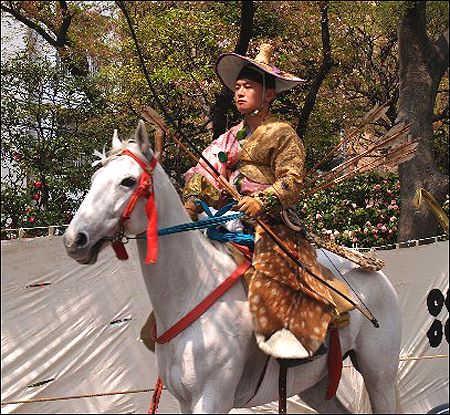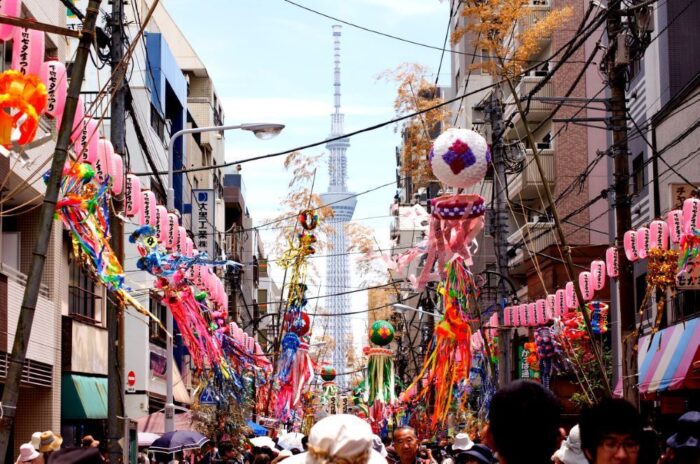Kyoto’s Kasagake Shinji is a thrilling equestrian tradition that captures the attention of tourists worldwide. Held at the Kamigamo Shrine, this event showcases Japan’s rich cultural heritage and simulates military maneuvers on the battlefield.
With strategically placed targets of varying heights, the experience is made even more realistic. Taking place in October, the event starts at 12:30 PM, followed by archery at 1:00 PM. English commentary ensures all visitors can understand and appreciate the ritual.

Horses, considered sacred animals and messengers for the gods, play a significant role in this captivating event. Additionally, the Aouma-Shinji ritual, influenced by Chinese history, takes place at the Sumiyoshi Taisha, using wooden tablets inscribed with wishes and prayers.
The Kasagake Shinji at the Kamigamo Shrine offers not only a thrilling experience with skilled riders and horses but also a deep insight into Japan’s cultural heritage.
Key Takeaways
- Kasagake Shinji is a traditional equestrian event held in Kyoto that showcases Japan’s rich cultural heritage.
- The event takes place at Kamigamo Shrine and simulates military maneuvers on the battlefield.
- There are five different targets strategically placed to simulate military maneuvers, making it a more realistic equestrian event.
- The event occurs in October, with archery starting at 1:00 PM, and provides commentary in English to ensure visitors can understand and enjoy the ritual.
What is Kasagake Shinji?
Kasagake Shinji is a traditional equestrian event held at Kamigamo Shrine in Kyoto. It showcases Japan’s rich cultural heritage and simulates military maneuvers on the battlefield.
This event has a long history and holds great significance in Japanese culture. It dates back to the Heian period and was initially held as a practice for samurai warriors. Over time, it evolved into a ritual to pray for victory in battle and to honor the gods.
Today, Kasagake Shinji continues to be an important cultural event, attracting both locals and tourists. Its cultural impact is immense, as it provides a glimpse into Japan’s ancient traditions and the skills of skilled equestrians.
The event not only preserves the country’s cultural heritage but also serves as a reminder of the bravery and dedication of samurai warriors.
Targets and Maneuvers
Riders strategically aim for five different targets placed at various heights to simulate military maneuvers on the battlefield. The traditional equestrian techniques used in Kasagake Shinji showcase the historical significance of these targets.
Here are four interesting facts about the targets and maneuvers:
- The targets are strategically placed to recreate the challenges faced by ancient warriors during battles.
- Three of the targets are set at shoulder height, known as Tōkasagake, requiring precise aim and coordination.
- The remaining two targets, called Kokasagake, are placed closer to the ground, challenging the riders’ agility and control.
- These targets not only test the riders’ skills but also serve as reminders of Japan’s rich martial history and the importance of accuracy in combat.
Participating in Kasagake Shinji allows riders to experience the thrill of traditional equestrian techniques while honoring the historical significance of these targets.
Timing and Rituals
The timing of Kasagake Shinji usually occurs in October, providing visitors with an opportunity to witness the traditional rituals associated with this cultural event.
The event starts around 12:30 PM and features archery that begins at 1:00 PM, with commentary in English to ensure that visitors can understand and enjoy the ritual.
Horses play a significant role in Shinto rituals and are considered sacred animals, believed to be animal messengers for the gods. This horse symbolism is deeply ingrained in Japanese culture.
The Kasagake Shinji takes place at the Kamigamo Shrine, which is of great importance for this event. The shrine showcases one of the three original styles of archery in Japan and mirrors the practice drills of archers during Japan’s warring period.
The breathtaking surroundings of the shrine add to the overall experience of witnessing this thrilling equestrian tradition.
Aouma-Shinji Ritual and Kamigamo Shrine
During the Aouma-Shinji ritual, participants from the Takeda-ryū school of mounted archery showcase their skills at the Kamigamo Shrine.
This ancient ritual holds great historical significance and is deeply rooted in Japanese culture. The Aouma-Shinji ritual is influenced by Chinese history and was originally held at Sumiyoshi Taisha.
However, it has been modernized with the use of wooden tablets called ema, which are inscribed with wishes and prayers and depict the image of a horse.
The Kamigamo Shrine itself is of utmost importance in the context of the Aouma-Shinji ritual as it showcases one of the three original styles of archery in Japan. The shrine serves as a testament to the rich history and traditions of this thrilling equestrian event.
Scoring and Cultural Experience
Participants in the Kasagake Shinji event at Kamigamo Shrine eagerly await the announcement of scores and hits after each run, adding an element of excitement and competition to the cultural experience.
The scoring system in Kasagake Shinji is crucial in determining the winners and progressing to the next round.
Here’s what makes the scoring and cultural immersion in this event so thrilling:
- Nail-biting anticipation: As the riders complete their runs, the audience holds their breath, waiting to hear the scores and hits. It creates a sense of excitement and keeps everyone on the edge of their seats.
- Cultural immersion: Kasagake Shinji offers a unique opportunity to immerse oneself in Japan’s rich cultural heritage. Witnessing the traditional equestrian event and understanding the scoring system adds depth to the overall experience.
- Competitive spirit: The announcement of scores and hits after each run fuels the competitive spirit among the riders. It brings out their determination to excel and perform their best, adding to the overall excitement of the event.
- Celebration of skill: The scoring system highlights the skill and precision of the riders. It showcases their mastery of archery techniques and horsemanship, making it a truly awe-inspiring spectacle.
Overall, the scoring excitement and cultural immersion in Kasagake Shinji create a captivating experience that allows participants to appreciate the beauty and traditions of Kyoto’s equestrian tradition.
Frequently Asked Questions
What is the significance of horses in Shinto rituals?
Horses hold historical significance and cultural symbolism in Shinto rituals. They are considered sacred animals and are believed to be messengers for the gods. They play a vital role in Shinto ceremonies and have a spiritual connection with Shinto deities.
How did the Aouma-Shinji Ritual at Sumiyoshi Taisha influence Kasagake Shinji?
The Aouma-Shinji ritual at Sumiyoshi Taisha influenced Kasagake Shinji by modernizing the use of wooden tablets (ema) instead of live horses. This evolution of techniques allowed for the depiction of horses and the continuation of the equestrian tradition.
Are there any specific requirements for participants from the Takeda-ryū school of mounted archery?
Participants from the Takeda-ryū school of mounted archery in Kasagake Shinji, a thrilling equestrian tradition in Kyoto, must meet specific requirements. These requirements ensure that participants are skilled in mounted archery and capable of performing the practice drills mirroring Japan’s warring period.
How do the targets in Kasagake Shinji change as the competition progresses?
The targets in Kasagake Shinji change as the competition progresses to test the riders’ accuracy. They start with larger shoulder-height targets and then progress to smaller targets. This evolution adds excitement and challenges to the event.
Besides Kasagake Shinji, what other exciting events can visitors consider attending in Kyoto during October?
Visitors to Kyoto in October can also enjoy food festivals and traditional tea ceremonies. These events offer a taste of local cuisine and a chance to experience the art of tea making, adding to the cultural richness of the city.
Conclusion
In conclusion, experiencing the Kasagake Shinji event in Kyoto is not just a thrilling equestrian tradition but also a fascinating glimpse into Japan’s rich cultural heritage.
With its simulated military maneuvers, strategically placed targets, and the sacred role of horses, this event truly immerses visitors in the traditions of the past.
Whether you witness the Aouma-Shinji ritual or explore the Kamigamo Shrine, you’ll find yourself captivated by the history and spirituality that surrounds this unique event.
Don’t miss the opportunity to witness the skill and precision of the riders and be a part of this cultural experience.



